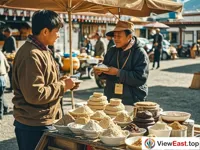







A: The Culture and Flavor Journey of Tsampa
Tibet, the mysterious land on the rooftop of the world, has given birth to an ancient and unique food—Tsampa. Tsampa is not only an essential part of the daily diet of the Tibetan people but also a microcosm of Tibetan culture. With its distinctive flavor, rich nutritional value, and profound cultural connotations, it has become an important window for exploring the lifestyle of Tibet.
Cultural Background
The history of Tsampa is ancient and closely linked to the religious beliefs and nomadic lifestyle of Tibet. In Tibet, Tsampa is the highest etiquette for entertaining guests and a simple food for monks during their practice. It symbolizes the tenacity of the Tibetan people and their reverence for nature.
Features and Taste
The specialty of Tsampa lies in its unique eating method and flavor. Made from roasted barley or pea flour, it is mixed with butter tea and kneaded into a dough with hands. The taste of Tsampa is distinctive, with a rough texture of grains and a delicate feel of butter, creating a rich and non-greasy flavor.
Appearance
The appearance of Tsampa is simple and unadorned, usually presenting as a light brown powder. When mixed with butter tea, it takes on a warm golden color that is very inviting.
Nutritional Value
The main ingredient of Tsampa is barley, which is rich in protein, dietary fiber, vitamins, and minerals, making it an ideal food for high-altitude regions. It provides sustained energy and helps resist the cold and oxygen-deficient environment of the plateau.
B: The Production Process of Tibetan Tsampa
Introduction of Ingredients
The main ingredients include barley flour, butter, butter tea, sugar, salt, etc.
Production Tools
The tools required are a mortar and pestle, a bowl, a spoon, etc.
Ingredient Preparation
Sieve the barley flour to remove impurities.
Cut the butter into small pieces and set aside.
Cooking Steps
Place the barley flour in a bowl, add an appropriate amount of butter tea, and mix evenly with your hands.
Season with sugar or salt according to personal taste.
Knead the mixture into a dough with your hands, and it is ready to eat.
Seasoning Techniques
The seasoning of Tsampa can be adjusted according to personal taste. Traditional Tsampa usually includes butter and a small amount of sugar or salt. You can also add some dried fruits or nuts for additional flavor and nutrition.
Consumption Suggestions
Tsampa is best consumed in the morning or when you need to replenish energy, serving as a source of energy for the day. Paired with a cup of butter tea, you can better experience the flavor of Tsampa.